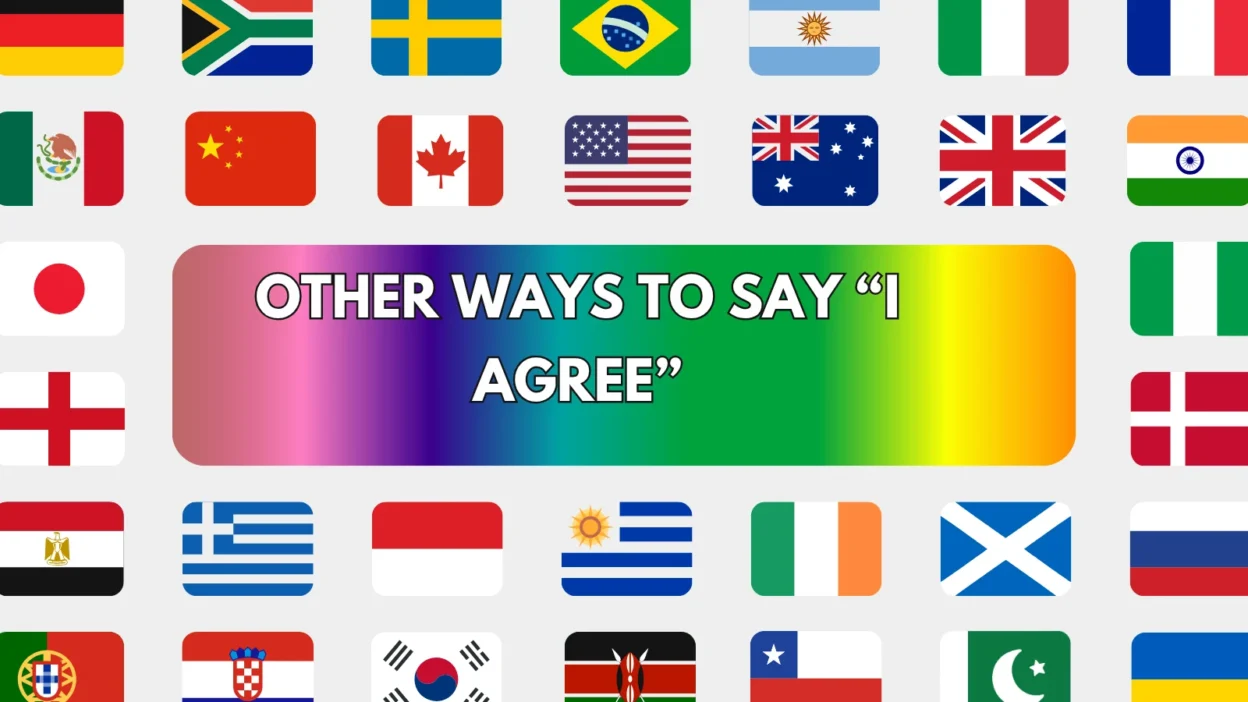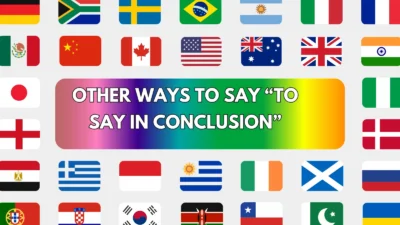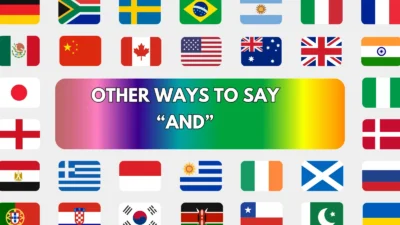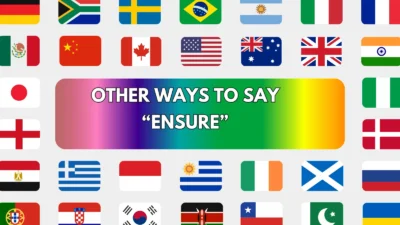Saying “I agree” is a direct and effective way to express alignment with someone’s opinion, idea, or statement. But repeating it over and over — especially in discussions, debates, meetings, or writing — can make your communication sound dull or limited.
This article gives you 25 professional and engaging alternatives to say “I agree,” each with its own tone and purpose. Whether you’re in a formal meeting or a casual conversation, you’ll find fresh ways to show support and agreement.
1. Absolutely
Meaning:
Strong confirmation that you agree completely.
Detailed Explanation:
This word shows enthusiastic agreement and works well in both casual and professional settings.
Scenario Example:
Absolutely — that’s exactly what I was thinking regarding the deadline.
Best Use:
Meetings, quick replies, casual professional dialogue.
Tone:
Confident, enthusiastic.
2. I couldn’t agree more
Meaning:
Expresses total agreement with no hesitation.
Detailed Explanation:
A more emphatic version of “I agree” that reinforces alignment with passion.
Scenario Example:
I couldn’t agree more — your strategy is both smart and timely.
Best Use:
Persuasive writing, team discussions, supportive replies.
Tone:
Strong, supportive.
3. That’s exactly how I see it
Meaning:
Indicates your perspective aligns perfectly with someone else’s.
Detailed Explanation:
Adds a personal touch while showing thoughtful agreement.
Scenario Example:
That’s exactly how I see it — improving user experience must be the top priority.
Best Use:
Team meetings, collaborative brainstorming.
Tone:
Personal, thoughtful.
4. You’re absolutely right
Meaning:
Acknowledges someone’s point as fully correct.
Detailed Explanation:
Shows validation and gives credit to the other person for their idea.
Scenario Example:
You’re absolutely right — we do need to streamline the onboarding process.
Best Use:
Professional feedback, supportive discussions.
Tone:
Respectful, affirming.
5. I’m with you on that
Meaning:
Casually shows you’re on the same page with someone.
Detailed Explanation:
Friendly and modern, great for building rapport in conversations.
Scenario Example:
I’m with you on that — it’s time for a more flexible schedule.
Best Use:
Peer conversations, informal professional chats.
Tone:
Casual, agreeable.
6. I feel the same way
Meaning:
Expresses emotional or personal agreement.
Detailed Explanation:
Adds empathy, often used when discussing experiences or opinions.
Scenario Example:
I feel the same way about remote work — it boosts productivity.
Best Use:
Supportive discussions, relationship building.
Tone:
Warm, empathetic.
7. Exactly
Meaning:
Affirms that someone’s statement is 100% accurate.
Detailed Explanation:
One word, but powerful. Shows sharp, quick agreement in conversation.
Scenario Example:
Exactly — focusing on quality over speed makes all the difference.
Best Use:
Short replies, active listening.
Tone:
Concise, strong.
8. That’s a valid point
Meaning:
Acknowledges the strength or truth of someone’s comment.
Detailed Explanation:
Polite and professional, this phrase encourages constructive dialogue.
Scenario Example:
That’s a valid point — especially considering our budget constraints.
Best Use:
Debates, group discussions, feedback settings.
Tone:
Diplomatic, respectful.
9. I’m on board with that
Meaning:
Shows you support an idea or plan.
Detailed Explanation:
Commonly used in team settings to show alignment and willingness to participate.
Scenario Example:
I’m on board with that strategy — let’s move forward.
Best Use:
Meetings, project planning.
Tone:
Supportive, team-oriented.
10. That works for me
Meaning:
Indicates that you are okay with a suggestion or plan.
Detailed Explanation:
More flexible and practical, often used when agreeing to a proposed arrangement.
Scenario Example:
Friday afternoon works? That works for me.
Best Use:
Scheduling, logistics.
Tone:
Neutral, cooperative.
11. I support that
Meaning:
Shows backing or endorsement of an idea or proposal.
Detailed Explanation:
Professional and affirming, often used in decision-making or team input.
Scenario Example:
I support that recommendation to expand the pilot program.
Best Use:
Votes, decisions, formal settings.
Tone:
Confident, professional.
12. That’s a good point
Meaning:
Acknowledges and affirms someone’s contribution.
Detailed Explanation:
Common in professional settings to recognize insight or accuracy.
Scenario Example:
That’s a good point — reducing steps could improve conversion rates.
Best Use:
Meetings, polite debate.
Tone:
Respectful, validating.
13. I agree with that perspective
Meaning:
Confirms alignment with someone’s viewpoint.
Detailed Explanation:
Adds depth to your agreement by showing understanding of a particular angle.
Scenario Example:
I agree with that perspective on user feedback — it’s valuable insight.
Best Use:
Strategic discussions, stakeholder communication.
Tone:
Reflective, thoughtful.
14. I see where you’re coming from
Meaning:
Acknowledges and agrees with the reasoning behind someone’s view.
Detailed Explanation:
Demonstrates empathy and validation even if agreement is partial.
Scenario Example:
I see where you’re coming from — reducing complexity does help speed.
Best Use:
Conflict resolution, collaborative work.
Tone:
Open, understanding.
15. I’m in agreement
Meaning:
Formal way to state that you agree.
Detailed Explanation:
Used in professional documents, formal speech, or meetings.
Scenario Example:
I’m in agreement with the proposed changes in policy.
Best Use:
Reports, business writing.
Tone:
Formal, direct.
16. I back that up
Meaning:
Expresses support for what was said.
Detailed Explanation:
Shows not only agreement but also willingness to stand behind someone’s point.
Scenario Example:
I back that up — we’ve seen similar patterns in the last quarter.
Best Use:
Team presentations, collaborative work.
Tone:
Assertive, cooperative.
17. No doubt about it
Meaning:
Strongly affirms that something is true or right.
Detailed Explanation:
Expresses certainty and full agreement in a confident way.
Scenario Example:
No doubt about it — this was the right decision.
Best Use:
Reinforcement in discussions.
Tone:
Strong, assertive.
18. That makes sense to me
Meaning:
Acknowledges logic and clarity in someone’s point.
Detailed Explanation:
Calm and thoughtful, showing you find the idea reasonable and acceptable.
Scenario Example:
That makes sense to me — especially given the timeline.
Best Use:
Problem-solving sessions, planning meetings.
Tone:
Measured, rational.
19. We’re on the same page
Meaning:
Shows shared understanding and alignment.
Detailed Explanation:
Common in teamwork to confirm agreement and clarity.
Scenario Example:
Glad we’re on the same page about the launch timeline.
Best Use:
Collaborative work, internal alignment.
Tone:
Collegial, positive.
20. I’m aligned with that
Meaning:
Indicates shared objectives or vision.
Detailed Explanation:
Frequently used in business language to show strategic agreement.
Scenario Example:
I’m aligned with that direction and ready to move forward.
Best Use:
Strategy, planning, leadership settings.
Tone:
Professional, forward-thinking.
21. I hear you and agree
Meaning:
Validates the other person’s point and confirms agreement.
Detailed Explanation:
Combines listening with agreement — useful in sensitive conversations.
Scenario Example:
I hear you and agree — we need better communication.
Best Use:
Feedback sessions, team check-ins.
Tone:
Empathetic, respectful.
22. Couldn’t have said it better myself
Meaning:
Strongly agrees while complimenting how it was expressed.
Detailed Explanation:
Adds humor or charm while showing strong alignment.
Scenario Example:
Couldn’t have said it better myself — that’s spot on.
Best Use:
Friendly discussions, meetings.
Tone:
Light-hearted, informal.
23. Agreed
Meaning:
Simple, quick confirmation.
Detailed Explanation:
One-word alternative to “I agree,” often used in chats or quick replies.
Scenario Example:
Agreed — let’s proceed with that version of the campaign.
Best Use:
Messaging, Slack, informal team exchanges.
Tone:
Concise, direct.
24. You took the words out of my mouth
Meaning:
The other person said exactly what you were thinking.
Detailed Explanation:
Playful and expressive — used to show strong agreement with flair.
Scenario Example:
You took the words out of my mouth! That’s exactly what I was about to say.
Best Use:
Casual chats, relationship-building.
Tone:
Friendly, light.
25. That aligns with my thoughts
Meaning:
Confirms your thinking matches the other person’s.
Detailed Explanation:
A polished and professional way to say “I agree” without overusing the phrase.
Scenario Example:
That aligns with my thoughts on team expansion.
Best Use:
Emails, business meetings, strategic discussion.
Tone:
Professional, polished.
Conclusion
Saying “I agree” doesn’t have to be repetitive or plain. With these 25 thoughtful and professional alternatives, you can express agreement in ways that sound confident, respectful, and engaging — tailored to any setting or tone.




